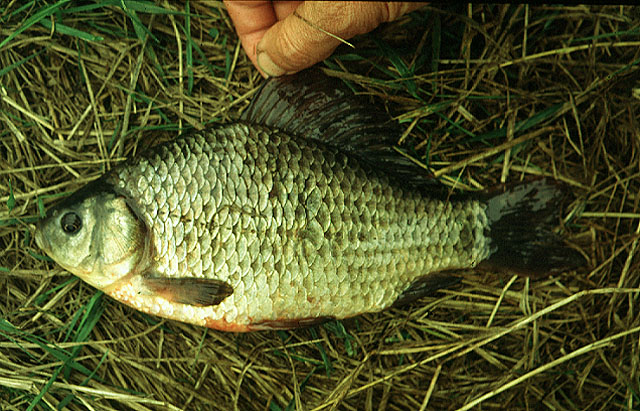| Cyprinidae (Minnows or carps), subfamily: Cyprininae |
| 64 cm TL (male/unsexed); max.weight: 3,000.0 g; max. reported age: 10 years |
|
demersal; depth range - 5 m, potamodromous |
| Eurasia: North, Baltic, White, Barents, Black and Caspian Sea basins; Aegean Sea basin only in Maritza drainage; eastward to Kolyma drainage (Siberia); westward to Rhine and eastern drainages of England. Absent from North Sea basin in Sweden and Norway. In Baltic basin north to about 66°N. Widely introduced to Italy, England and France but possibly often confused with Carassius gibelio (Ref. 59043). At least one country reports adverse ecological impact after introduction. |
|
Dorsal spines (total): 3-4; Dorsal soft rays (total): 13-22; Anal spines: 2-3; Anal soft rays: 5-7; Vertebrae: 32-32. Diagnosed from its congeners in Europe by having the following characters: body golden-green shining color; last simple anal and dorsal rays weakly serrated; 23-33 gill rakers; lateral line with 31-36 scales; free edge of dorsal convex; anal fin usually with 6½ branched rays; and peritoneum white (Ref. 59043). Caudal fin with 18-20 rays (Ref. 2196). No barbels. The third dorsal and anal-fin rays are strong and serrated posteriorly. |
| Adults occur in shallow ponds, lakes rich in vegetation and slow moving rivers. They burrow in mud in the dry season or during winter (Ref. 2163). Usually restricted to densely vegetated backwaters and oxbows of lowland rivers. Can survive at high temperatures and at very low oxygen concentrations during summer and under ice cover (Ref. 59043). Tolerates cold, organic pollutants, and low oxygen levels in the water (Ref. 30578). Feeds all day but mainly at night on plankton, benthic invertebrates, plant materials and detritus. Usually does not occur in waters with rich ichthyofauna and abundant predatory species, but very abundant in the absence of other fish species. Spawns in dense submerged vegetation (Ref. 59043). Marketed fresh and frozen; eaten fried, broiled and baked (Ref. 9988). Live up to about 10 years. There is a gradual but continuing extirpation in many water bodies, especially in Danube drainage and central Europe, possibly to due competition with introduced Carassius gibelio in non-optimal habitats (Ref. 59043). |
|
(Ref. 96402)
|
| potential pest |
|
Source and more info: www.fishbase.org. For personal, classroom, and other internal use only. Not for publication.
Page created by Jen, 05.08.02,
php script by kbanasihan 06/09/2010 ,
last modified by
dsantos, 20/08/10

